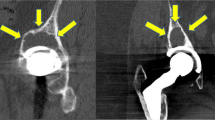Abstract
We prospectively studied a consecutive series of 60 primary total hip arthroplasties in 52 patients. All patients had a hydroxyapatite-coated hemispherical acetabular cup (OCTOFIT). Mean patient age was 52.5 (34–73) years. In 38 hips, a 28-mm and in 22 hips a 32-mm diameter cobalt-chrome femoral head was used. We could follow 53 hips for a mean of 81 (28–125) months. Four cups were revised because of osteolysis, and in another six cups, slight osteolysis without migration was seen. The average annual linear wear rate was 0.05 mm (±0.05) for 28-mm heads and 0.16 mm (±0.09) for 32-mm heads (p<0.0001). Survivorship analysis predicted a survival rate of 86±6.7% at 10 years.
Résumé
Nous avons étudié de façon prospective une série consécutive de 60 arthroplasties totales primaires de hanche chez 52 malades. Tous les malades avaient une cupule acétabulaire hémisphérique enduite d’hydroxyapatite (OCTOFIT). L’âge moyen des malades était de 52,5 ans (34–73). La tête était en chrome-cobalt, de 28 mm pour 38 hanches et de 32 mm pour 22 hanches. Nous avons suivi 53 hanches pendant une moyenne de 82 mois(28–125). Quatre cupules ont été révisées à cause d’une ostéolyse et pour six autres cupules exixtait une discrète ostéolyse sans migration. L’usure linéaire moyenne annuelle était de 0,05 mm (±0,05) pour les têtes de 28 mm et 0,16 mm (±0,09) pour les têtes de 32 mm (p<0,0001). L’analyse de Kaplan–Meier a prédit un taux de la survie de 86±6,7% à 10 années.

Similar content being viewed by others
References
Barrack RL, Folgueras A, Munn B, Tvetden D, Sharkey P (1997) Pelvic lysis and polyethylene wear at 5–8 years in an uncemented total hip. Clin Orthop 335:211–217
Blacha J (2004) High osteolysis and revision ratio after total hip arthroplasty with hydroxyapatite coated ABG hip prostheses followed 5–9 years. Acta Orthop Scand (in press)
Brooker AF, Bowerman JW, Robinson RA, Riley LH (1973) Ectopic ossification following total hip arthroplasty: incidence and method of classification. J Bone Joint Surg Am 55:1629–1632
Capello WN, D’Antonio JA, Manley MT, Feinberg JR (1998) Hydroxyapatite in total hip arthroplasty. Clin Orthop 355:200–211
Chung YY, Kim HD, Kim KS (2002) Bone ingrowth on smooth-surfaced hydroxyapatite-coated acetabular cup. Int Orthop 26:283–286
Claus AM, Sychterz CJ, Hopper RH Jr, Engh CA (2001) Pattern of osteolysis around two different cementless metal-backed cups: retrospective, radiographic analysis at minimum 10 years follow-up. J Arthroplasty 16:177–182
D’Antonio JA, Capello WN, Manley MT, Feinberg J (1997) Hydroxyapatite coated implants. Total hip arthroplasty in the young patients and patients with avascular necrosis. Clin Orthop 344:124–138
DeLee JG, Charnley J (1976) Radiological demarcation of cemented sockets in total hip replacement. Clin Orthop 121:20–32
Dorr LD, Wan Z, Cohen J (1998) Hemispheric titanium porous coated acetabular component without screw fixation. Clin Orthop 351:158–168
Dunkley AB, Eldridge JDJ, Lee MB, Smith EJ, Learmonth ID (2000) Cementless acetabular replacement in the young. A 5 to 10 year prospective study. Clin Orthop 376:149–155
Giannikas KA, Din R, Sadiq S, Dunningham TH (2002) Medium-term result of the ABG total hip arthroplasty in young patients. J Arthroplasty 17:184–188
Gruen TA, McNeice GM, Amstutz HC (1976) Modes of failure of cemented stem-type femoral components: a radiographic analysis of loosening. Clin Orthop 141:17–27
Harris WH (1969) Traumatic arthritis of hip after dislocation and acetabular fractures. Treatment by mold arthroplasty. An end result study using a new method of result evaluation. J Bone Joint Surg Am 51:737–755
Kim YH, Oh SH, Kim JS (2003) Primary total hip arthroplasty with a second-generation cementless total hip prosthesis in patients younger than fifty years of age. J Bone Joint Surg Am 85:109–114
Latimer HA, Lachiewicz PF (1996) Porous-coated acetabular components with screw fixation. J Bone Joint Surg Am 78:975–981
Livermore J, Ilstrup MS, Morrey B (1999) Effect of femoral head size on wear of the polyethylene acetabular component. J Bone Joint Surg Am 72:518–528
Manley MT, Capello WN, D’Antonio JA, Edidin AA, Geesink RG (1998) Fixation of acetabular cups without cement in total hip arthroplasty. A comparison of three different implant surfaces at a minimum duration of follow-up of five years. J Bone Joint Surg Am 80:1175–1185
Manley MT, D’Antonio JA, Capello WN, Edidin AA (2002) Osteolysis: a disease of access to fixation interfaces. Clin Orthop 405:129–137
Morscher EW, Hefti A, Aebi U (1998) Severe osteolysis after third-body wear due to hydroxyapatite particles from acetabular cup coating. J Bone Joint Surg Br 80:267–272
Oosterbos CJM, Rahmy AIA, Tonino AJ (2001) Hydroxyapatite-coated hip prosthesis followed up for five years. Int Orthop 25:17–21
Rokkum M, Brandt M, Bye K, Hetland KR, Waage S, Reigstad A (1999) Polyethylene wear, osteolysis and acetabular loosening with an HA-coated hip prosthesis. A follow-up of 94 consecutive arthroplasties. J. Bone Joint Surg Br 81:582–589
Soballe K, Hansen ES, Brockstedt-Rasmussen H, Hjortdal VE, Juhl GI, Pedersen CM, Hvid I, Buenger C (1991) Gap healing enhanced by hydroxyapatite coating in dogs. Clin Orthop 272:300–307
Thanner J, Karrholm J, Malchau H, Herberts P (1999) Poor outcome of the PCA and Harris-Galante hip prostheses. Randomized study of 171 artrhroplasties with 9-year follow-up. Acta Orthop Scand 70:155–162
Thanner J, Karrholm J, Herberts P, Malchau H (2000) Hydroxyapatite and tricalcium phosphate-coated cups with and without screw fixation: a randomized study of 64 hips. J Arthroplasty 15:405–412
Tonino AJ, Rahmy AIA, International ABG study Group (2000) The hydroxyapatite—ABG hip system. 5 to 7 year results from an International Multicenter Study. J Arthroplasty 15:274–282
Author information
Authors and Affiliations
Corresponding author
Rights and permissions
About this article
Cite this article
Blacha, J., Gągała, J. Clinical and radiological results of hydroxyapatite-coated acetabular cups. International Orthopaedics (SICOT) 28, 362–365 (2004). https://doi.org/10.1007/s00264-004-0563-0
Received:
Accepted:
Published:
Issue Date:
DOI: https://doi.org/10.1007/s00264-004-0563-0




